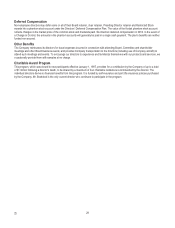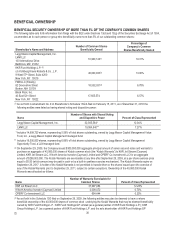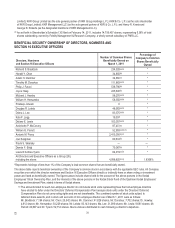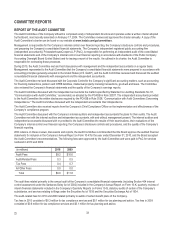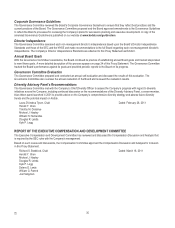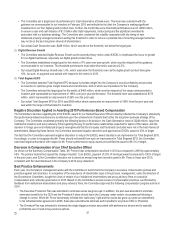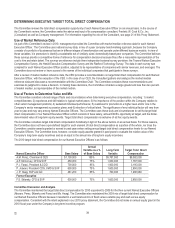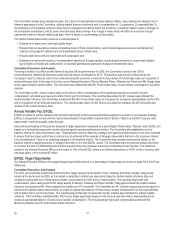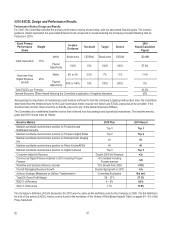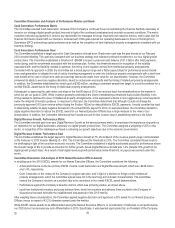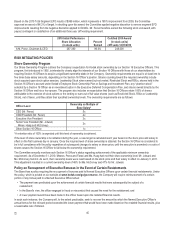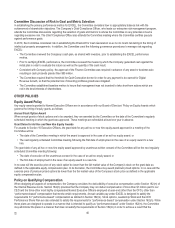Kodak 2010 Annual Report Download - page 163
Download and view the complete annual report
Please find page 163 of the 2010 Kodak annual report below. You can navigate through the pages in the report by either clicking on the pages listed below, or by using the keyword search tool below to find specific information within the annual report.
37
• The Committee set a target level of performance for Cash Generation at break-even. This level was consistent with the
guidance we communicated to our investors in February 2010 and reflects the fact that the Company is making significant
investments in our four digital growth product lines. Further, the Committee set a threshold performance level of -$350 million,
to ensure a year-end cash balance of $1.5 billion after debt repayments, restructuring and the significant investments
associated with our business strategy. The Committee also considered the volatility associated with the timing of new
intellectual property arrangements when setting this threshold in order to remove a potential risk of incenting arrangements that
may not be in the best long-term interest of shareholders.
• Our actual Cash Generation was -$248 million, which was above the threshold, but below the target goal.
2) Digital Revenue Growth
• The Committee selected Digital Revenue Growth as the second primary metric under EXCEL to emphasize the focus on growth
for our digital businesses, especially our digital growth product lines.
• The Committee established a target goal for this metric of 7% year-over-year growth, which was the midpoint of the guidance
communicated to our investors. The threshold performance level under this metric was set at 2.5%.
• Our actual Digital Revenue Growth was 1.4%, which was below the threshold, even as the digital growth product lines grew
18%. As such, no payment was earned with respect to this metric in 2010.
3) Total Segment EFO
• The Committee selected Total Segment EFO because it provides insight into the Company’s overall profitability and provides
an incentive to optimize gross margin dollars and cost structure, both of which are imperatives for the Company.
• The Committee selected the target goal for this metric at $400 million, which was the midpoint of the range communicated to
investors and represented an improvement of 188% over prior year performance. The threshold level was established at $175
million, which represented an improvement of 26% over the prior year.
• Our actual Total Segment EFO for 2010 was $369 million which represented an improvement of 165% from the prior year and
was within the range communicated to investors.
Negative Discretion Applied in Awarding 2010 Performance-Based Compensation
The Committee’s decision regarding the 2010 EXCEL award for our Named Executive Officers directly reflected the Company’s philosophy
that performance-based incentives are conditioned upon the achievement of results that further the long-term business strategy of the
Company. The Committee considered primarily the following factors in its decision: the Cash Generation result of -$248 million; input from
institutional investors and proxy advisory firms regarding the pay for performance relationships expected for plans of this nature; and the
decision to forego year-end intellectual property arrangements that the Company and the Board concluded were not in the best interest of
shareholders. Balancing these factors, the Committee exercised negative discretion and approved an EXCEL award of 20% of target.
The fact that the Committee exercised negative discretion to reduce the EXCEL award resulted in an improvement in Total Segment EFO.
Accordingly, in order to recognize that Mr. Perez should not benefit from such an improvement in Total Segment EFO, the Committee
exercised negative discretion with respect to Mr. Perez’s performance equity award and certified the award at 86.3% of target.
Decrease in Compensation of our Chief Executive Officer
As shown on the Summary Compensation Table, Mr. Perez’s total compensation declined in 2010 as compared to 2009 by approximately
55%. The primary factors that caused this change included: 1) an EXCEL payment of 20% of his target award (compared to 100% of target
in the prior year); and 2) the Committee’s decision not to award an annual long-term incentive grant to Mr. Perez in fiscal year 2010,
consistent with the intent disclosed in the Company’s 2010 proxy statement.
Best Practice Enhancements
Each year, the Company’s management works with the Committee to benchmark the Company’s executive compensation policies and
practices against best practices. In recognition of the importance of shareholder input in this process, management, under the direction of
the Governance Committee, sought the views of certain of our institutional shareholders and proxy advisory firms on executive
compensation and corporate governance in 2010. Based on the Committee’s annual review of compensation practices, as informed by
feedback from institutional shareholders and proxy advisory firms, the Committee approved the following compensation program actions in
2010:
• The Executive Protection Plan was amended to eliminate excise tax-gross ups. In addition, the plan was amended to eliminate
severance benefits for the CEO and the President if either should leave the Company under certain circumstances following a
change in control. While Mr. Perez had already forfeited this “walk away” right and the excise tax gross up under an amendment
to his individual letter agreement in 2009, these plan amendments eliminate such benefits for any future CEO or President.
• The Omnibus Plan was amended to eliminate the single trigger provision associated with performance shares and to explicitly
prohibit the use of cash to buyout stock options.




